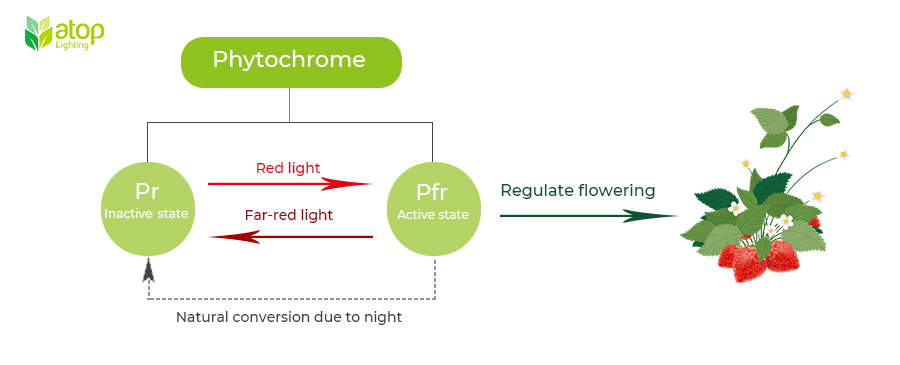How Far-red Light Boosts Flowering
Flowering is a crucial in the life cycle of many plants, especially those that are grown for ornamental or agriculture purposes. Flowering is influenced by various environmental factors, such as temperature, day length, and light quality. As is known, light spectrum in the PAR range can be used by plants to create energy through photosynthesis. Many have heard about the benefits of using far-red light to manipulate the flowering of crops. But far-red light falls outside of the PAR range. How far-red light boosts flowering? How to apply far-red light properly to boost flowering?
What is far-red light
Far-red light also is known as far-red radiation. Far-red light is photons of light with wavelengths ranging from 700 to 800nm. These photons are beyond the visible red light to human eyes. Far-red light has a profound effect on plants, especially on their photoperiodic response, which is the ability to sense day length and initiate flowering accordingly. The difference between red and far-red light can regulate plant growth. Therefore, the balance between red and far-red light can help you extend the growth and promote flowering of your plants.

Far-red light VS red light
Since red light and far-red light have similar effects on plants, far-red light is commonly miscategorized as red light. In fact, far-red light is not the same as red light. Red light ranges from 600 to 700 nm, and it can encourage budding and flowering. It is considered one of the most important light colors for photosynthesis and biomass growth.
The main differences between far-red light and red light include:
- Far-red light has a wavelength range of 700 to 800 nm, while red light has a wavelength range of 600 to 700 nm.
- Far-red light is invisible to the human eye, but red light is visible to the human eye.
- Far-red light is perceived by plants through a photoreceptor called phytochrome. While red light is absorbed by plants for photosynthesis.

How far-red light affects flowering
Most plants regulate their flowering to reflect the length of day and night. Generally speaking, long-day plants flower when they receive more than a critical day length, while short-day plants flower when they receive less than a critical day length. Far-red light can affect the photoperiodic response of plants. It means it can regulate the ability of plants to sense day length.
However, it is not only the duration of light that matters but also the quality. Far-red light can alter the photoperiodic response of plants by changing the R:FR ratio and affecting the phytochrome equilibrium. Plants have special pigments called phytochromes that act as light sensors and switch between two forms: Pr and Pfr. Pr absorbs red light and converts to Pfr, while Pfr absorbs far-red light and converts to Pr. The ratio of Pr to Pfr (or R:FR ratio) changes throughout the day and night, depending on the light quality and quantity. Plants use this ratio as a signal to determine whether they are in long days or short days and whether they should flower or not.

How to use far-red light to boost flowering
Exposing plants to far-red light can convince the plant that it has had a longer dark period, and the plant will initiates flowering more quickly. Using far-red light can help growers get up to 20% more production per year. 20% of additional production can be huge for most growers! How to apply far-red light appropriately to boost flowering?
The first method is to use a blast of far-red light at the end of the day. Generally, plants require 12 hour of darkness for flowering. Exposing a plant to far-red light for a short period (10 - 30 minutes) before the start of the dark period can reduce the time for flowering. It makes the plant “think” it has had a longer dark period and triggers the plant to flower.
Another way to boost flowering is by using all far-red light at the beginning of the dark period. An effective example is using far-red light to shorten flowering time. Commercial growers normally use a 12/12 light cycle during the flowering stage of cannabis. Switch off the blue, white, and red radiation at the end of the 12-hour light cycle and leave the far-red light at full power to finish the cycle. By using this method, growers can significantly shorten the flowering by 10 to 14 days.
If you want to promote flowering, increase yields, or give you plants an indoor environment close to outdoor one, upgrading your light with far-red is critical. There are different ways to apply far-red light to your crops, such as using LED grow lights, HPS lights, or natural sunlight. LED grow lights are becoming more popular because they offer more control over the light spectrum, intensity, timing, and uniformity. They also consume less energy and generate less than other artificial lights. However, not all LED fixtures are good enough for far-red applications, as some may have low output or poor quality. At Atop Lighting, we have a wide range of efficient LED grow lights that meet your plant’s need for far-red light. Contact us to discover our amazing products.


